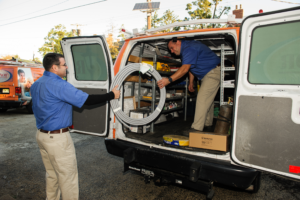Are you tired of the hassles and expenses associated with oil heating for your home? If so, you’re not alone. A growing number of homeowners are switching from oil to gas for their home heating systems, and for good reason. Here, we’ll explore the benefits and steps involved in the oil-to-gas conversion process, helping you make a smarter choice for your home heating system.
Economic Benefits
One of the primary drivers for converting from oil to gas heat is the significant cost savings. Gas heating is generally more cost-effective than oil, making it a smart financial move. The savings can be substantial, and they add up over time.
Environmental Benefits
Gas heating is a cleaner and more environmentally friendly option than oil heating. Natural gas produces fewer carbon emissions, contributing to a smaller carbon footprint. As concerns surrounding environmental impact and sustainability grow, switching to gas is an eco-conscious choice.
Efficiency and Convenience
Gas heating systems are known for their efficiency. They can reach efficiency levels of up to 98%. In contrast, older oil heaters often struggle to reach efficiency above 60%, resulting in higher energy bills and poor utilization of the oil. So you are paying for 100% and only 60% is really being used.
Reliable Supply
Natural gas is a domestically sourced fuel, which means it is more readily available and less susceptible to price fluctuations caused by global events. This reliability ensures a consistent supply of fuel for your home heating needs.
Steps for Oil to Gas Conversion
- Assessment
The conversion process begins with an assessment of your current home heating system. A professional technician will evaluate your existing system and determine the feasibility of the conversion.
- Oil Tank Removal
If you have an oil storage tank on your property, it needs to be removed. This removal should be done by professionals who can ensure the tank is emptied, cleaned, and disposed of properly. They should also handle all the required permits and inspections.
- Gas Line Installation
A gas line connects your home to the municipal gas supply. Permits must be applied for and approved. Installation involves laying gas pipes and ensuring a secure connection to your property. Then you need to have inspections to make sure that the gas piping is installed safely and to current codes.
- Appliance Installation
Existing heating appliances need to be replaced with gas-powered ones. Proper sizing and installation are necessary for efficiency, proper heating and indoor air quality for your family.
- Permits and Inspections
The conversion process typically requires permits and inspections to keep your home compliant with local regulations. Your contractor will handle the necessary paperwork and inspections.
- Professional Installation
Professional installation is crucial for a successful oil-to-gas conversion. Raynor’s 30+ years of experience and highly trained and experienced technicians ensure your new gas heating system is installed correctly and safely.
- Enjoy!
Once the conversion is complete, you can start enjoying the benefits of gas heat immediately. You’ll notice lower energy bills, increased efficiency, and a more environmentally friendly heating solution.
Converting from oil to gas is an excellent choice for homeowners looking for cost savings, environmental benefits, and improved heating efficiency. While the process is involved and requires a financial investment, the long-term advantages make it worthwhile. When you switch to gas heating, you’ll get both economic benefits and contribute to a cleaner, greener future.
If you’re considering an oil-to-gas conversion for your home heating system, consult with Raynor Services’ HVAC contractors. We can guide you through the process, ensure a smooth transition, and help you enjoy all the advantages of gas heating. Say goodbye to the inconveniences of oil and embrace the benefits of a more efficient and environmentally friendly home heating solution.



